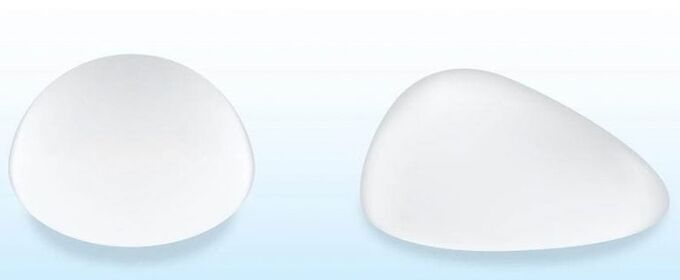Shaping and breast augmentation is one of the most popular plastic surgeries. With the help of mammoplasty, you can correct congenital or acquired breast defects, restore volume, elasticity after childbirth and breastfeeding. Properly performed surgery helps a woman to be more attractive and confident.
Tips for surgery
- Decreased and reduced elasticity of the mammary glands (mastoptosis).
- Increased breast volume while maintaining tone and position (macropathy).
- Decreased mammary glands after lactation.
- Small breast size (micromastia).
- Increased breast volume in men (gynecomastia).
Types of mammoplasty
- Enlargement mammoplasty(endoprosthesis) - breast augmentation, correction of the shape using implants. It is used after childbirth, breastfeeding, congenital asymmetry.
- Reduction of mammoplasty- Reduction of bust size with mastoptosis or macropathy.
- Mastopexy- breast lift. If the breast volume meets the requirements for surgery, it is indicated for mastoptosis.
Endoprosthesis of mammary glands
The operation involves the installation of silicone prostheses (implants) in the mammary glands. It is up to the woman to choose the place of cutting. The implant is placed under the pectoral muscle and, if the breast volume allows, between the muscle and the mammary gland. The incision is made, drainage is not required. After the operation, the nipple and areola expand.
Breast implants
Silicone or polyurethane endoprostheses correct the size and shape of the bust, feel the natural tissues of the body.
Implants have a service life of more than 15 years, after which it is recommended to replace them.

The products differ in a number of indicators:
- Fillers: adhesive gels or saline (sodium chloride). The composition of the gels is more elastic, homogeneous, light, but if it leaks, it is dangerous for the body. Salt solution is safer, softer, cheaper. Disadvantages - gurgles when moving, prone to leakage.
- Structure: rough (textured) or smooth. Tissue implants are more durable, but skin wrinkles can be seen by rubbing against the surface of body tissues. The disadvantage of straight prostheses is the possibility of displacement.
- Shape: anatomical or round. The former has a more natural appearance, while the latter maintains the symmetry and shape of the chest even when removed.
Reduction of mammoplasty
During this type of surgery, adipose tissue and breast tissue are partially removed, resized, and given a new shape.
Removal of excess tissue reduces the risk of cancer.
Reducing mammoplasty options:
- Liposuction. The method is considered conservative and does not leave seams. Designed for small breast reduction with mild degrees of mastoptosis.
- Short (vertical) stitching. It is a popular method that preserves the natural shape of the breasts and makes the nipples sensitive. The operation takes less time and the complication rate is low.
- T-shaped (anchor) cut. The classic method used to remove large amounts of tissue. The disadvantages are the recovery time, a large scar.
- Amputation with breast transplantation. Used on very large breasts. The method is associated with the risk of damage to the mammary glands, loss of breast sensitivity and inability to breastfeed.
Mastopexy
Breast augmentation without implants is possible in several ways:
- Used for vertical mastoptosis 1-2 degrees, the seams are almost invisible, the cosmetic effect is long-lasting. The method of lowering the chest by 3-4 degrees is ineffective.
- Ankle mastopexy gives good results for ptosis of any complexity. Disadvantages include a longer recovery period, noticeable stitches, and an increased risk of breast tissue damage.
- Periareolar mastopexy is the removal of a small skin around the areola. Indicated for pseudoptosis, ineffective for other forms of bust sagging.
Stages of operation
High quality medical care in all 3 stages is important for excellent results of plastic surgery. The preparation period lasts 1-2 weeks. The actual surgery lasts between 1 and 4 hours.
Full recovery occurs within 1, 5 months.
Preparation for mammoplasty

The operation is performed one year after the end of lactation. It is forbidden to take hormonal contraceptives, aspirin and salicylates 2 weeks before the operation.
You should stop drinking alcohol and smoking.
During the preparation, research is carried out:
- general and biochemical blood tests;
- electrocardiogram;
- blood test for anticoagulants (coagulogram);
- Ultrasound of the mammary glands;
- general urinalysis
- tests for hepatitis and HIV viruses.
The course of surgery

Bust plasticity is performed under general anesthesia. It is a special type of expanding dermotension. It is used to increase breast volume due to its lack of tissue and large implant sizes. The procedure is performed in 2 stages. First, an expander is installed to gradually lengthen the breast tissue over a period of 1, 5-2 months.
When you reach the desired size, an endoprosthesis is placed on the breast.
Surgical cutting methods:
- From the crease under the breast (infantile entrance). A safe method for augmentation mammoplasty. The scar from a 4-5 cm long incision disappears over time under the slightly lowered breast. It is difficult to enter with thin micromastia in thin girls.
- Incision around or along the lower arch of the areola (periareolar approach). Advantage - surgical scars are almost invisible. This method is not recommended for patients who plan to breastfeed because of the high risk of breast injury.
- Endoscopic magnification with axillary approach. High-tech equipment helps to install the implant without damaging blood vessels and nerve fibers. An incision 3-4 cm long is made in the axillary region and then the wound is naturally masked. There is a limit on the volume of the implant - up to 400 ml.
- Endoscopic access through the umbilicus. This method is rarely used due to the remoteness of the entry point from the operating area and the difficulty in forming a "pocket" for the prosthesis.
Rehabilitation after mammoplasty

If the operation is not complicated, the patient stays in the hospital for up to 3 days. After discharge, it is necessary to participate in dressings. Moderate pain in the area of the intervention that occurs in the first days is considered natural. Feelings of tightness of the skin are possible due to postoperative edema, which lasts about 5-7 days.
After 4-6 weeks, the breast bends slightly, looks more natural, and capsules form around the implants.
Rules for successful recovery:
- Do not load the shoulder girdle, do not lift weights.
- Do not visit fitness clubs, swimming pools, saunas, baths.
- Lie on your back.
- Do not raise your hands.
- Be sure to wear compression garments after breast augmentation.
Possible complications
- Capsular contracture. The body forms a crust that can move around the endoprosthesis, disrupting the symmetry and hardening of the mammary glands.
- Infection. Infection occurs due to violation of the rules of asepsis during surgery or non-compliance with antiseptic care standards. The special risk period is 1 week after surgery.
- Keloid, hypertrophic scars. They appear when the body is prone to formation. The shapes look like dense ridges rising above the surface of the skin and spoil the appearance of the breasts.
- Accumulation of blood, serous fluid (hematoma, seroma) and, consequently, darkening of the skin. Occurs when blood vessels or lymphatic vessels are damaged during surgery or recovery. Complications occur due to low blood clotting, a sharp rise in blood pressure, improperly sized endoprosthesis.
- Decreased or lost sensitivity of the mammary glands, areola. It often occurs when large breasts shrink with mammoplasty due to nerve damage.
- Implant hernia. It often occurs due to the thin shell in cheap prostheses. The salt filler is easily absorbed without harming the body. Damage to the endoprosthesis with an adhesive gel is not always noticeable, but it is dangerous if the silicone enters the body tissues.
Breastfeeding after surgery

The safest operation is performed under the armpit (transaxial) or under the breast (submummary).
Approximately one year after surgery, breastfeeding is allowed.
Lactation problems can occur in the following cases:
- Endoprostheses reduce the amount of milk they produce by squeezing the mammary glands.
- Cutting along the areola is more likely to damage the nerve endings around the nipple.
- Reducing plastic associated with a reduction in breast size disrupts the milk ducts, blocking their functions.
In what cases is breast plastic surgery contraindicated?
- Cardiovascular diseases, varicose veins (thrombophlebitis, thrombosis).
- Severe forms of mastopathy.
- Oncology.
- Blood clotting disorders, diabetes.
- Infectious diseases (ARVI, influenza).
- Neurological, mental disorders.
- Pregnancy, breastfeeding.
- Under 18 years old.
Advantages and disadvantages of mammoplasty

Advantages of plastic breast correction:
- Application of modern interventions.
- Correction of congenital and acquired defects of the mammary glands.
- Long-lasting and clear aesthetic effect.
- Short duration of the operation.
- Ability to choose the shape and material of endoprostheses as desired.
- Protection of lactation.
Possible disadvantages include:
- Skin marks from cuts - sutures, scars (unless special absorbent materials are used).
- Risk of complications (infection, breast deformity, bleeding).
- Endoprostheses should be replaced every 10-15 years.
- High cost of mammoplasty.
- The need for general anesthesia.
- Painful feelings in the first days after surgery.
- Need to wear compression underwear constantly.
- A long period of rehabilitation (from a few months to a year), refusing to exercise, physical activity, pregnancy, breastfeeding.


























